
点击上方「蓝字」关注我们

第3章 分组
一、SAC过程
1. 内涵
2. apply过程
二、groupby函数
1. 分组函数的基本内容:
2. groupby对象的特点
三、聚合、过滤和变换
1. 聚合(Aggregation)
2. 过滤(Filteration)
3. 变换(Transformation)
四、apply函数
1. apply函数的灵活性
2. 用apply同时统计多个指标
第3章 分组
import numpy as np
import pandas as pd
df = pd.read_csv('data/table.csv',index_col='ID')
df
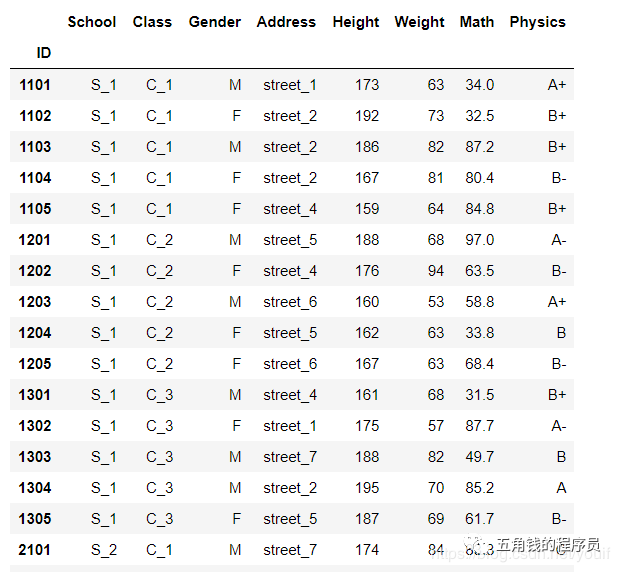
一、SAC过程
1. 内涵
1.SAC指的是分组操作中的split-apply-combine过程
2.其中split指基于某一些规则,将数据拆成若干组,apply是指对每一组独立地使用函
数,combine指将每一组的结果组合成某一类数据结构
2. apply过程
在该过程中,我们实际往往会遇到四类问题:
1.整合(Aggregation)——即分组计算统计量(如求均值、求每组元素个数)
2.变换(Transformation)——即分组对每个单元的数据进行操作(如元素标准化)
3.过滤(Filtration)——即按照某些规则筛选出一些组(如选出组内某一指标小于50的组)
综合问题——即前面提及的三种问题的混合
二、groupby函数
1. 分组函数的基本内容:
(a)根据某一列分组
grouped_single = df.groupby('School')
经过groupby后会生成一个groupby对象,该对象本身不会返回任何东西,只有当相应的方法被调用才会起作用
例如取出某一个组:
grouped_single.get_group('S_2').head()
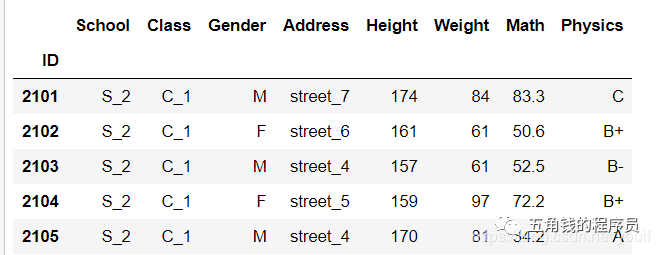
(b)根据某几列分组
grouped_mul = df.groupby(['School','Class'])
grouped_mul.get_group(('S_1','C_3'))
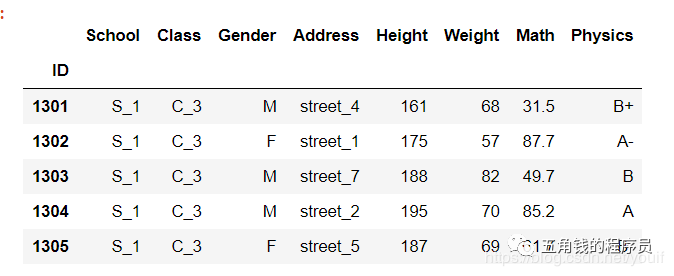
(c)组容量与组数
grouped_single.size()
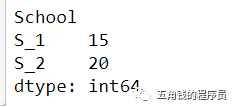
grouped_mul.size()
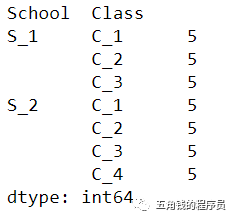
grouped_single.ngroups

grouped_mul.ngroups

(d)组的遍历
for name,group in grouped_single:
print(name)
display(group.head())
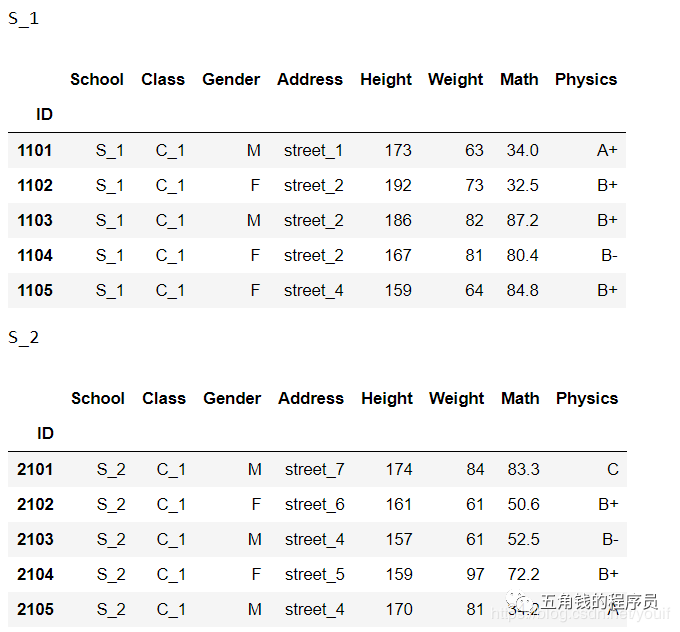
(e)level参数(用于多级索引)和axis参数
df.set_index(['Gender','School']).groupby(level=1,axis=0).get_group('S_1')
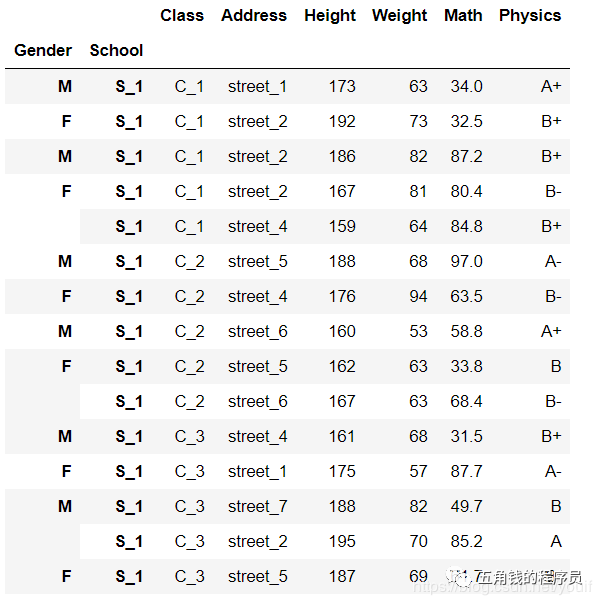
2. groupby对象的特点
(a)查看所有可调用的方法
由此可见,groupby对象可以使用相当多的函数,灵活程度很高
print([attr for attr in dir(grouped_single) if not attr.startswith('_')])

(b)分组对象的head和first
对分组对象使用head函数,返回的是每个组的前几行,而不是数据集前几行
grouped_single.head(3)
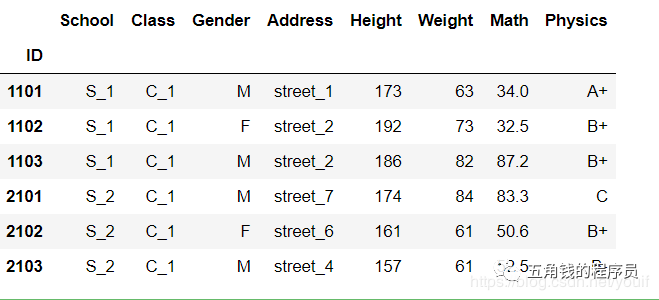
first显示的是以分组为索引的每组的第一个分组信息
grouped_single.first()

(c)分组依据
对于groupby函数而言,分组的依据是非常自由的,只要是与数据框长度相同的列表即可,同时支持函数型分组
np.random.choice(['a','b','c'],df.shape[0])

df.groupby(np.random.choice(['a','b','c'],df.shape[0])).get_group('b').head()
#相当于将np.random.choice(['a','b','c'],df.shape[0])当做新的一列进行分组
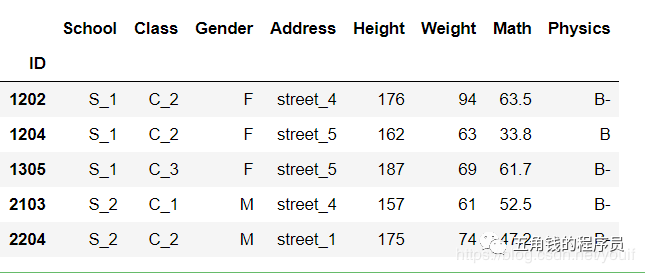
从原理上说,我们可以看到利用函数时,传入的对象就是索引,因此根据这一特性可以做一些复杂的操作
df[:5].groupby(lambda x:print(x)).head(0)

根据奇偶行分组
df.groupby(lambda x:'奇数行' if not df.index.get_loc(x)%2==1 else '偶数行').groups

如果是多层索引,那么lambda表达式中的输入就是元组,下面实现的功能为查看两所学校中男女生分别均分是否及格
注意:此处只是演示groupby的用法,实际操作不会这样写
math_score = df.set_index(['Gender','School'])['Math'].sort_index()
grouped_score = df.set_index(['Gender','School']).sort_index().groupby(lambda x:(x,'均分及格' if math_score[x].mean()>=60 else '均分不及格'))
for name,_ in grouped_score:
print(name)
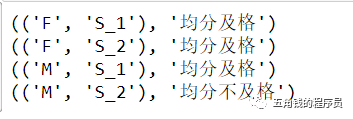
(d)groupby的[]操作
可以用[]选出groupby对象的某个或者某几个列,上面的均分比较可以如下简洁地写出:
df.groupby(['Gender','School'])['Math'].mean()>=60
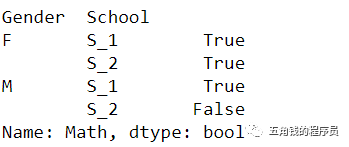
用列表可选出多个属性列:
df.groupby(['Gender','School'])[['Math','Height']].mean()
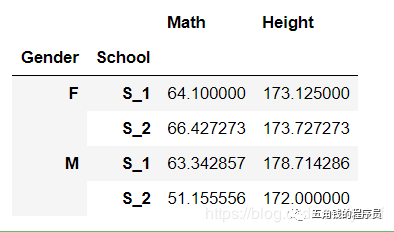
(e)连续型变量分组
例如利用cut函数对数学成绩分组:
bins = [0,40,60,80,90,100]
cuts = pd.cut(df['Math'],bins=bins) #可选label添加自定义标签
df.groupby(cuts)['Math'].count()
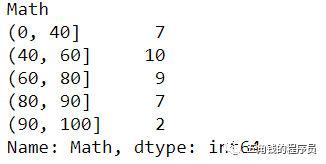
三、聚合、过滤和变换
1. 聚合(Aggregation)
(a)常用聚合函数
所谓聚合就是把一堆数,变成一个标量,因此mean/sum/size/count/std/var/sem/describe/first/last/nth/min/max都是聚合函数
为了熟悉操作,不妨验证标准误sem函数,它的计算公式是:,下面进行验证:
group_m = grouped_single['Math']
group_m.std().values/np.sqrt(group_m.count().values)== group_m.sem().values

(b)同时使用多个聚合函数
group_m.agg(['sum','mean','std'])
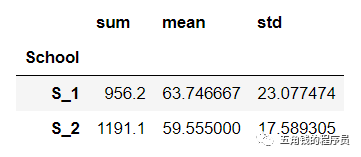
利用元组进行重命名
group_m.agg([('rename_sum','sum'),('rename_mean','mean')])
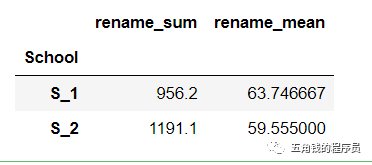
指定哪些函数作用哪些列
grouped_mul.agg({'Math':['mean','max'],'Height':'var'})
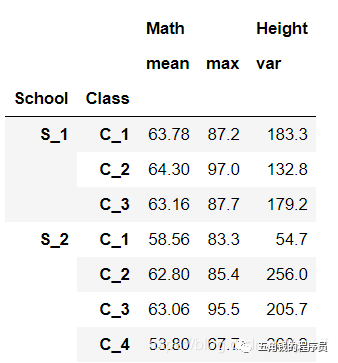
(c)使用自定义函数
grouped_single['Math'].agg(lambda x:print(x.head(),'间隔'))
#可以发现,agg函数的传入是分组逐列进行的,有了这个特性就可以做许多事情
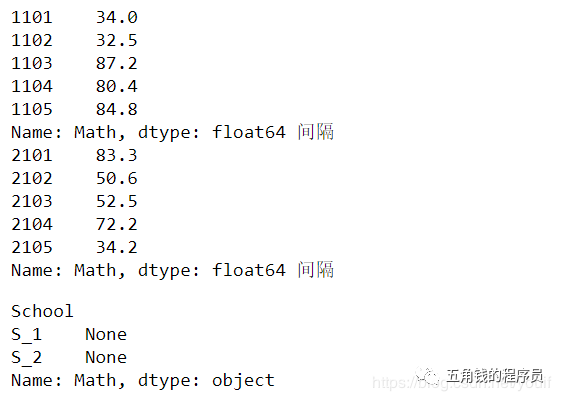
官方没有提供极差计算的函数,但通过agg可以容易地实现组内极差计算
grouped_single['Math'].agg(lambda x:x.max()-x.min())

(d)利用NamedAgg函数进行多个聚合
注意:不支持lambda函数,但是可以使用外置的def函数
def R1(x):
return x.max()-x.min()
def R2(x):
return x.max()-x.median()
grouped_single['Math'].agg(min_score1=pd.NamedAgg(column='col1', aggfunc=R1),
max_score1=pd.NamedAgg(column='col2', aggfunc='max'),
range_score2=pd.NamedAgg(column='col3', aggfunc=R2)).head()
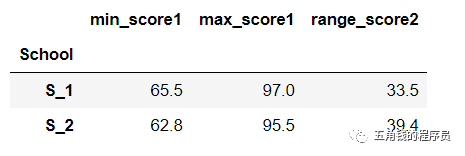
(e)带参数的聚合函数
判断是否组内数学分数至少有一个值在50-52之间:
def f(s,low,high):
return s.between(low,high).max()
grouped_single['Math'].agg(f,50,52)

如果需要使用多个函数,并且其中至少有一个带参数,则使用wrap技巧:
def f_test(s,low,high):
return s.between(low,high).max()
def agg_f(f_mul,name,*args,**kwargs):
def wrapper(x):
return f_mul(x,*args,**kwargs)
wrapper.__name__ = name
return wrapper
new_f = agg_f(f_test,'at_least_one_in_50_52',50,52)
grouped_single['Math'].agg([new_f,'mean']).head()
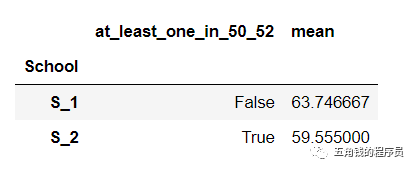
2. 过滤(Filteration)
filter函数是用来筛选某些组的(务必记住结果是组的全体),因此传入的值应当是布尔标量
grouped_single[['Math','Physics']].filter(lambda x:(x['Math']>32).all()).head()
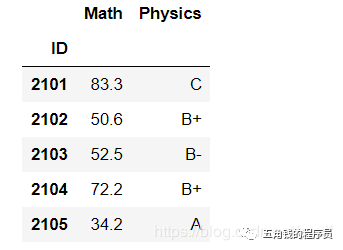
3. 变换(Transformation)
(a)传入对象
transform函数中传入的对象是组内的列,并且返回值需要与列长完全一致
grouped_single[['Math','Height']].transform(lambda x:x-x.min()).head()
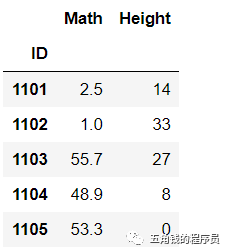
如果返回了标量值,那么组内的所有元素会被广播为这个值
grouped_single[['Math','Height']].transform(lambda x:x.mean()).head()
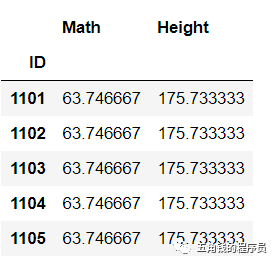
(b)利用变换方法进行组内标准化
grouped_single[['Math','Height']].transform(lambda x:(x-x.mean())/x.std()).head()
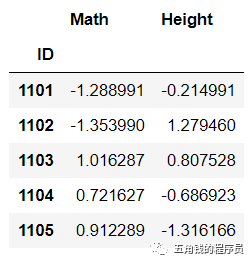
(c)利用变换方法进行组内缺失值的均值填充
df_nan = df[['Math','School']].copy().reset_index()
df_nan.loc[np.random.randint(0,df.shape[0],25),['Math']]=np.nan
df_nan.head()
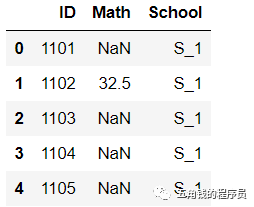
df_nan.groupby('School').transform(lambda x: x.fillna(x.mean())).join(df.reset_index()['School']).head()
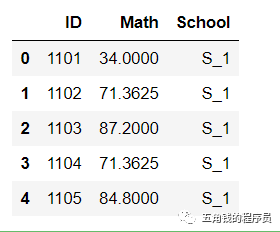
四、apply函数
1. apply函数的灵活性
可能在所有的分组函数中,apply是应用最为广泛的,这得益于它的灵活性:
对于传入值而言,从下面的打印内容可以看到是以分组的表传入apply中:
df.groupby('School').apply(lambda x:print(x.head(1)))

apply函数的灵活性很大程度来源于其返回值的多样性:
① 标量返回值
df[['School','Math','Height']].groupby('School').apply(lambda x:x.max())
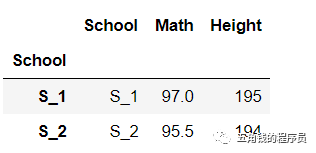
② 列表返回值
df[['School','Math','Height']].groupby('School').apply(lambda x:x-x.min()).head()
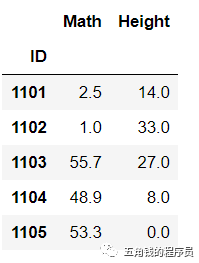
③ 数据框返回值
df[['School','Math','Height']].groupby('School')\
.apply(lambda x:pd.DataFrame({'col1':x['Math']-x['Math'].max(),
'col2':x['Math']-x['Math'].min(),
'col3':x['Height']-x['Height'].max(),
'col4':x['Height']-x['Height'].min()})).head()
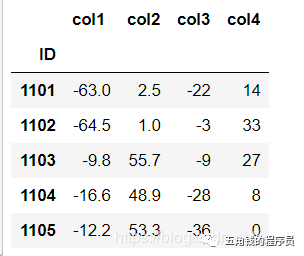
2. 用apply同时统计多个指标
此处可以借助OrderedDict工具进行快捷的统计:
from collections import OrderedDict
def f(df):
data = OrderedDict()
data['M_sum'] = df['Math'].sum()
data['W_var'] = df['Weight'].var()
data['H_mean'] = df['Height'].mean()
return pd.Series(data)
grouped_single.apply(f)
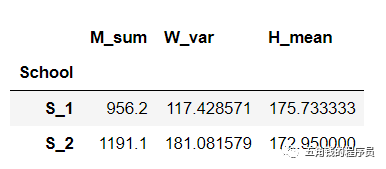
代码和数据地址:https://github.com/XiangLinPro/pandas
所有巧合的是要么是上天注定要么是一个人偷偷的在努力。
公众号,关注回复【电子书】有惊喜,资源多多。
个人微信公众号,专注于学习资源、笔记分享,欢迎关注。我们一起成长,一起学习。一直纯真着,善良着,温情地热爱生活,,如果觉得有点用的话,请不要吝啬你手中点赞的权力,谢谢我亲爱的读者朋友。
The only person you need to compare yourself to is who you have been. The only person you need to be better than is who you are.
你需要跟自己比的唯一一个人,就是曾经的自己。你需要比一个人变得更好,那个人就是现在的你。
给大家推荐一个Github,上面非常非常多的干货,保证让你满意:https://github.com/XiangLinPro/IT_book
关于Datawhale
Datawhale是一个专注于数据科学与AI领域的开源组织,汇集了众多领域院校和知名企业的优秀学习者,聚合了一群有开源精神和探索精神的团队成员。Datawhale以“for the learner,和学习者一起成长”为愿景,鼓励真实地展现自我、开放包容、互信互助、敢于试错和勇于担当。同时Datawhale 用开源的理念去探索开源内容、开源学习和开源方案,赋能人才培养,助力人才成长,建立起人与人,人与知识,人与企业和人与未来的联结。
The mature never ask about the past;
the wise never ask about the present
and the open-minded never ask about the future.
成熟的人不问过去,
聪明的人不问现在,
豁达的人不问未来。

本文分享自微信公众号 - 五角钱的程序员(xianglin965)。
如有侵权,请联系 support@oschina.cn 删除。
本文参与“OSC源创计划”,欢迎正在阅读的你也加入,一起分享。
来源:oschina
链接:https://my.oschina.net/u/4594538/blog/4441041